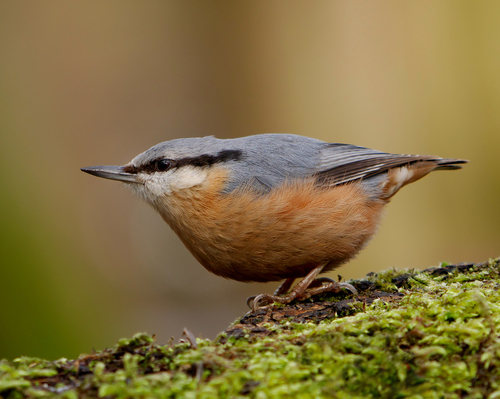
Eurasian Nuthatch
The Eurasian Nuthatch (*Sitta europaea*) is a small, energetic passerine bird known for its unique ability to climb down tree trunks headfirst, a behavior not commonly seen in other birds. It plays a vital role in forest ecosystems by controlling insect populations and dispersing seeds. Found across Europe and Asia, the Eurasian Nuthatch's vibrant plumage and distinctive calls make it a favorite among birdwatchers. Culturally, nuthatches are sometimes seen as symbols of resourcefulness and diligence due to their habit of storing food.
12-14.5 cm
Length
22.5-27 cm
Wingspan
Least Concern
Conservation Status
Distribution
The Eurasian Nuthatch is widespread across Europe, Asia, and parts of North Africa. Its range extends from the British Isles and Iberia eastward across Russia to Japan, and south to the Mediterranean, the Middle East, and Southeast Asia. It is generally non-migratory, except in the northernmost parts of its range where some populations may move south for winter.
Lifespan
Typically 2-3 years in the wild, but can live up to 10 years.
Eurasian Nuthatch's Habitat
Habitat Types
Deciduous woodlands, Mixed forests, Parks, Mature gardens, Wooded areas with old-growth trees
Climate Zones
Temperate, Boreal, Subtropical (in parts of Asia)
Adaptations
Strong legs and claws allow the Nuthatch to cling to and move along tree bark in any direction, including headfirst downwards. Its strong bill is adapted for hammering open nuts and seeds.
Variations
Numerous subspecies exist across the extensive range, differing slightly in plumage coloration and size. For instance, *S. e. caesia* in Western Europe has a buff underside, while *S. e. europaea* in Scandinavia has a white underside.
Appearance
Breeding Plumage
Plumage remains similar throughout the year, but may be slightly brighter during the breeding season.
Seasonal Feather Changes
Minimal seasonal variation.
Sex Based Plumage Differences
Males generally have more intensely colored chestnut flanks and a darker eyestripe than females.
Notable Features
Blue-gray upperparts, Black eyestripe, White cheeks and throat, Chestnut flanks (intensity varies by subspecies), Short, square tail
Diet and Feeding
Primary Foods
Insects, Spiders, Seeds, Nuts, Acorns
Foraging Behavior
Forages on tree trunks and branches, probing bark crevices for insects and spiders. It also wedges nuts and seeds into crevices and hammers them open with its bill. Known to store food in caches for later consumption.
Specializations
Strong bill and neck muscles for hammering. Exceptional climbing ability allows access to food sources unavailable to many other birds.
Seasonal Diet Variations
Diet shifts with seasonal availability. Insects and spiders are dominant in spring and summer, while seeds and nuts are more important in autumn and winter.
Behavior
Social Structure
Generally solitary or in pairs outside of the breeding season. May join mixed-species flocks in winter.
Communication
Variety of calls, including a loud, repeated 'chwit-chwit-chwit', A nasal 'tui tui tui', A soft, trilling song, Visual displays, such as tail spreading during courtship
Migration
Mostly resident, but some northern populations may undertake short-distance migrations or altitudinal movements in winter.
Territorial or Group Behaviors
Highly territorial during the breeding season, defending their nesting site and foraging area. Territories are smaller in winter.
Conservation
Threats
Habitat loss and fragmentation due to deforestation and urbanization, Loss of old-growth trees, which provide nesting cavities, Use of pesticides, which can reduce insect prey availability
Protection Programs
Habitat conservation and restoration efforts, Provision of nest boxes in areas lacking natural cavities, Promotion of sustainable forestry practices
Local National Laws
Protected under various national and international wildlife protection laws, such as the EU Birds Directive.
Population Trend
Stable
Population Estimates
Estimated global population of 45.9-228 million mature individuals.
Interesting Facts
They are named for their habit of wedging nuts into bark and 'hacking' at them.
The name 'nuthatch' is derived from 'nut-hack'.
They can run down trees headfirst.
This unusual behavior allows them to access food sources that other birds cannot reach.
They often plaster mud around the entrance of their nest hole.
This is thought to reduce the size of the entrance, deterring predators or competitors.
They cache food, like squirrels.
They hide seeds and nuts in crevices for later consumption, demonstrating remarkable spatial memory.
Faqs about Eurasian Nuthatch
What do Eurasian Nuthatches eat?
They eat insects, spiders, seeds, and nuts. Their diet varies seasonally, with more insects in summer and more seeds and nuts in winter.
Where do Eurasian Nuthatches live?
They live in deciduous and mixed woodlands, parks, and gardens across Europe and Asia.
Are Eurasian Nuthatches migratory?
Most populations are resident, but some northern populations may migrate short distances in winter.
How can I attract Eurasian Nuthatches to my garden?
Provide a bird feeder with sunflower seeds, peanuts, or suet. Putting up nest boxes can also attract them.
Copyright @ Nature Style Limited. All Rights Reserved.
 English
English